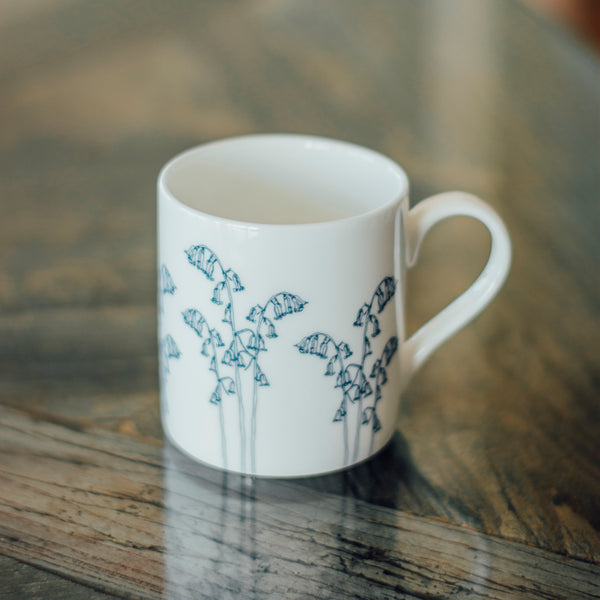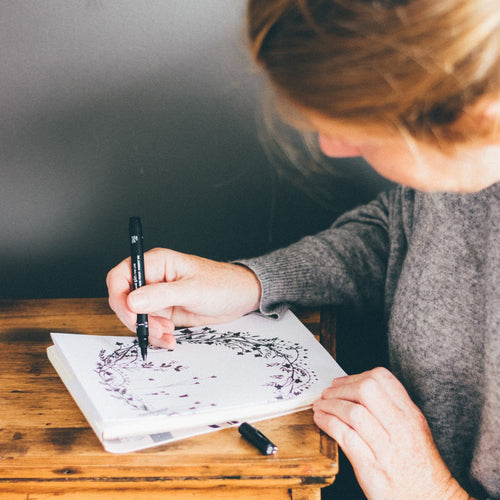Our Honey Bee collection is one of our most popular designs. Launched in the summer of 2017, it celebrates the importance of the Honey Bee in our lives.

Looking back at the blog that I wrote then, it's fascinating how much we have extended our range to include, alongside our lovely linen products, stationery, including a range of recyclable bee packing tape and most recently bee gift wrapping paper.
The inspiration for our Honey Bee Collection comes from my father Roger, who is a beekeeper. He's kept bees for years and now has over 20 beehives on a small piece of managed woodland. He is passionate about helping to protect and increase honeybee colonies. He encourages others to take up bee keeping as a hobby and gives support to new apiarists. We sell his honey in our shop when it is available (in person only). Honey is very sticky stuff and doesn’t travel well!
With the bee species in serious danger from intensive farming methods and increased use of pesticides, creating a collection dedicated to these magical little flying insects has given me great satisfaction.
My father has an incredible wealth of bee keeping knowledge. He breeds bees for other beekeepers and can often be found up a tree catching a swarm...much to my Mother's horror, I might add!!
His hives are the scene of much activity during the summer months and there is always a pot of honey on the kitchen counter for me to take home when I visit..... along with eggs from my Mother's chickens of course.
My interest in Honey Bees is always sparked at this time of year, as I encounter them on my walks and in the garden. I've just been working out what they are doing now and I thought it might be good to share this with you so you also know what these wonderful creative creatures are up to.
Honey Bees Lifecycle - thank you to the Woodland Trust for this information
- Honey Bees' lives revolve around their hive and queen
- In the spring, the warmer temperatures wake the queens from their hibernation and they’ll seek nectar to feed on before finding a suitable nest site for the year
- Having already mated before they hibernated, they will lay their first brood of eggs in early summer, which will produce female worker bees
- In early summer they live in a nest made up of a queen bee and female worker bees
- As summer progresses, the queen lays eggs which produce a new generation of queen bees and male bees
- The colony eventually leaves the nest and mates, with the young queens collecting nectar and pollen to build up fat in their bodies
- Eventually, the new queens hibernate alone underground, with their vital fat stores helping them survive through the winter
- The rest of the nest - including the old queen, the male bees and the female worker bees - falls away with the leaves, dying out through autumn
How can we help our Bee Population?
If you have a garden, then bee-friendly gardening is a great way to start!
Diverse planting helps - aim for a good variety of pollen-rich flowers that have different flower shapes. Ensure your flowering plants extend from early spring to late summer and even throughout the winter if you can.
Wildflowers and native species are bee friendly - and usually they are easy to grow and are relatively resistant to pests. Because native plants have evolved with our native insects, they are naturally beneficial for each other. Here are some bee friendly plants you might want to include: Bluebell, Foxglove, Comfrey, Clover, Greater Knapweed, Hellebore, Wood Anemone.
Some trees and shrubs are also great for bees as they provide masses of flowers in one place. Good winter and early spring flowering trees are apple, wild cherry, willow and hazel.
Avoid pesticides, particularly those containing neonicotinoids (thiacloprid and acetamiprid) kill bees! Read the label and avoid using them.
Make a bee house - create insect houses in your garden to provide nesting sites for solitary bees and insects. Different bee species require different habitats. You can make your own simple bee house or you can buy one. Bee boxes need a south-facing spot, not in direct sunlight, with the entrance pointing down to keep the rain out.
Go easy on lawn weeds - weeds like dandelions are excellent bee plants, providing vital pollen early in the spring. White clover attracts masses of honeybees. If you don’t want a shaggy lawn, leave a patch that’s mown less frequently to give weeds a chance to flower.
Bee Aware!
As you get out and about in the next few weeks, whether it’s into your garden or just out on a spring walk, spend a little time watching the bees at work, they never stop. I find their buzzing incredibly soothing.
I’m often reminded of this song that I sang with my children when they were little, which isn’t soothing at all! It’s sometimes in my head when I am developing our new bee products and reminds me of the importance of our bees and honestly makes me smile each time I start humming it.
Let me know if you have any plans to find ways to support our bee population, this year, I’d love to hear from you. Or if you have any pictures of our beautiful Honey Bee Collection in your home, post them on Facebook or Instagram. It's always wonderful to see our products in your home.
Look out for more bee information in our newsletters, if you aren't already subscribed click here to subscribe for the latest information on events, promotions and new products.










Leave a comment